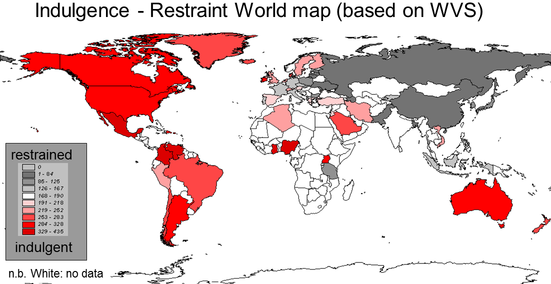These 6 cultural differences explain everything
As the world grapples with covid, it’s fascinating to see how differently each country has approached the pandemic. And with wildly different results.
Why is it that one country has NO problem convincing its citizens to wear masks and get vaccinated (am I right Cambodia?)
While another country (ahem… ‘murica) ends up with punches thrown over mask-wearing in the sausage aisle at Walmart.
In a few years, when you rummage through your old clothes and find a used mask in a pocket, you will smile…behind your hazmat suit's visor.
But covid isn’t the only place we see massive cultural differences. Those of us called to serve cross-culturally find these differences to be a constant source of wonder and frustration.
Luckily for us, a nerdy Dutch professor has come up with the definitive guide to cultural difference, by identifying six major ways we differ across the world. Geert Hofstede came up with these six ways societies express, and reinforce, what they value. He calls it the 6D model of National Difference.
You might protest, “Well, I’m not the same as everyone else in my country!” And that’s true of course. But while there are individual differences within each society, these differences are like drops of water in a mighty river - they don’t change the general direction of that culture.
The culture shock you experience when you go to another country and wonder why the HECK they are doing things so strangely, attests to the fact that there are huge cultural differences in the world.
So, are you ready to dive in?
1. Individualism vs Collectivism
I’ve written about the fascinating roots of this cultural difference before. In most Western cultures, an individualistic worldview allows each person to carve their own way through life, to find their own freedom and happiness, with less need to consider the impact on anyone else.
(By the way, the United States is the most individualistic society on earth - 91 out of 100 on Hofstede’s scale.)
The good news is, individualism is strongly correlated with trying new things. When you try something new, you are choosing to do something different to those around you. You make your own decisions, which is highly valued.
In contrast, collectivism is a worldview where each person "knows their place" in life and in society. This worldview, rooted in harmony, holds a much clearer picture of the interrelatedness of all things. The collectivist worldview sees how every action a person takes impacts everyone around them.
In these collectivist cultures trying something new can be considered a rejection of others. Which is not a good thing socially.
For Reflection:
How might introducing new ideas (eg. new religious ideas), need to be approached differently in individualistic cultures versus collective cultures?
Are there alternative ways to frame “the gospel” beyond the Western worldview that centres guilt (an internal/individual concept) instead of shame (which by definition is experienced in the context of others)?
2. Power Distance
A culture with a large Power Distance is one where those with less power accept that power is distributed unequally. They are OK with being told what to do. Sometimes you get treated like dirt. That’s to be expected! Russia, China, Mexico and Cambodia are all countries with a very large Power Distance.
For example, when I first did the dishes at the office, my Cambodian colleagues were shocked. The so-called “boss” doesn’t do that kind of work! I realized that I was being confronted by the expectations of a large Power Distance.
In contrast, cultures like New Zealand, Australia or the United States, have much smaller Power Distances, and society is much more egalitarian. The boss is supposed to be a team player, on the same level as everyone else. Telling others what to do is seen as “lording it over” other people. Tall poppy syndrome reigns.
For Reflection:
How might a large Power Distance impact the way you enter a culture where you are wealthier (and thus seen as more powerful) than others, especially if you are from a country with a small Power Distance?
How might people’s perception of God in each society differ? Is Jesus a friend or an almighty king?
3. Masculinity vs Femininity
Masculinity is the extent to which the use of force is socially endorsed. Looking powerful, decisive, and strong is highly valued in what Hofstede calls “masculine” societies.
In a masculine society, men are supposed to be tough, and winning is important for both genders. Quantity is important, and big is beautiful. This is reflected in a higher masculinity score for the US on Hofstede’s scale. Patriarchy is strong.
In a more “feminine” society, such as in certain Scandinavian cultures, the genders are emotionally closer. Competing is not so openly endorsed, and there is more sympathy for the underdog.
For Reflection:
How might conflict be navigated for those from a traditionally more “masculine” society when they find themselves in a more “feminine” culture? What about vice versa?
How might believers from a more “masculine,” competitive context be tempted to treat believers of another religion?
4. Uncertainty Avoidance
Uncertainty avoidance refers to a culture’s tolerance for ambiguity.
Uncertainty avoiding societies feel anxiety and distrust in the face of the unknown. What is different is dangerous. There is a need for lots of rules, even when these rules are impractical or illogical. These cultures have fixed habits and rituals, and drive to know the truth. Japan is an example of an uncertainty avoiding culture.
In contrast, for cultures that are comfortable with ambiguity, difference represents an opportunity for tolerance and learning. After all, you only need rules when you are going to use them. Uncertainty and ambiguity is acceptable. France, Mexico and the United States are low on this scale.
For Reflection:
How might someone from a society which avoids uncertainty respond to outsiders with very different norms and cultural practices. How do YOU respond?
5. Long-term vs Short-term Orientation
In a long-term oriented society, such as Japan or China, the basic notion about the world is that it is in flux. Which means you need to always be preparing for the future. The past provides a moral compass, and adhering to it is morally good. Change is slow. Tradition is important.
In a short-term oriented culture, time is money. We want quick and easy solutions. We move fast and break things. Sound familiar? That’s because many Western countries have a short term orientation.
For Reflection:
How might change be introduced in a society with a long-term orientation, where tradition is deeply held, and rapid change is frowned upon?
How might our expectation of impact need to be adjusted if we are serving in a long-term oriented society?
6. Indulgence vs Restraint
In an indulgent culture, it is good to be free to do whatever you want. Free love. Dancing. Violent crime. Doing what your impulses nudge you to do is highly valued. Friendships and a vibrant social life are important. Mexico scores the highest in the world on this scale, with 97 out of 100. The US scores 68.
In contrast, in a restrained culture, the feeling is that life is hard. Duty, not freedom, is the most important value. In restrained societies, self discipline and responsibility are very important.
For Reflection:
How might an indulgent society respond to covid restrictions, versus a restrained society?
How might members of an indulgent culture approach faith, versus members of a restrained culture?
Can you see how these cultural differences might influence everything from our response to covid restrictions, to our response to outsiders?
Knowing yourself and your home culture is a good start. But recognizing that other cultures have equally valid approaches to life, and values, can give you more understanding for those situations that drive you up the wall.
Finally, consider these holy words about diversity…
"I want you to think about how all this makes you more significant, not less. A body isn’t just a single part blown up into something huge. It’s all the different-but-similar parts arranged and functioning together." (1 Corinthians 12:14)
How does this framework resonate with you for your own culture and the cultures you interact with? Let me know in the comments below.
[This is just a brief overview of the topic. For more info check out this Freakonomics podcast episode or visit Geert Hofstede’s website here. Map credit: Geert Hofstede.]







